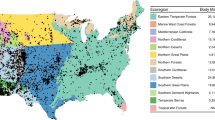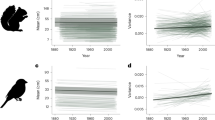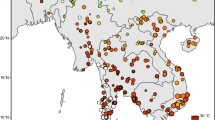Abstract
We describe a biogeographic pattern in which mammalian body size extremes scale with landmass area. The relationship between the largest and the smallest mammal species found on different landbridge islands, mountaintops and continents shows that the size of the largest species increases, while that of the smallest species decreases, with increase in the area of the landmass. We offer two possible explanations: (1) that the pattern is the result of sampling artefacts, which we call the ‘statistical artefact hypothesis’, or (2) that the pattern is the result of processes related to the way body size affects the number of individuals that a particular species can pack in a given area, which we call the ‘area-scaling hypothesis’. Our results point out that the pattern is not a statistical artefact resulting from random sampling, but can be explained by considering the scaling of individual space requirements and its effect on population survival on landmasses of different area.
Similar content being viewed by others
References
Balakrishnan, N. and Cohen, A.C. (1991) Order Statistics and Inference: Estimation Methods. Academic Press, San Diego, CA.
Behrensmeyer, A.K., Damuth, J.D., DiMichele, W.A., Potts, R., Sues, H.-D. and Wing, S.L. (eds) (1992) Terrestrial Ecosystems Through Time: Evolutionary Paleoecology of Terrestrial Plants and Animals. The University of Chicago Press, Chicago, IL.
Blackburn, T.M., Brown, V.K., Doube, B.M., Greenwood, J.J.D., Lawton, J.H. and Stork, N.E. (1993) The relationship between abundance and body size in natural animal assemblages. J Anim. Ecol. 62, 519–528.
Bonner, J.T. (1988) The Evolution of Complexity. Princeton University Press, Princeton, NJ.
Brown, J.H. (1971) Mammals on mountaintops: Nonequilibrium insular biogeography. Am. Nat. 105, 467–478.
Brown, J.H. (1978) The theory of insular biogeography and the distribution of boreal birds and mammals. Great Basin Nat. Memor. 2, 209–228.
Brown, J.H. (1995) Macroecology. The University of Chicago Press, Chicago, IL.
Brown, J.H. and Kodric-Brown, A. (1977) Turnover rates in insular biogeography: Effect of inmigration on extinction. Ecology 58, 445–449.
Brown, J.H. and Maurer, B.A. (1987) Evolution of species assemblages: Effects of energetics constraints and species dynamics on the diversification of the North American avifauna. Am. Nat. 130, 1–17.
Brown, J.H. and Maurer, B.A. (1989) Macroecology: The division of food and space among species on continents. Science 243, 1145–1150.
Brown, J.H. and Nicoletto, P.F. (1991) Spatial scaling of species composition: Body masses of North American land mammmals. Am. Nat. 138, 1478–1512.
Brown, J.H. and Zeng, Z. (1989) Comparative population ecology of eleven species of rodents in the Chihuahuan desert. Ecology 70, 1507–1525.
Brown, J.H., Marquet, P.A. and Taper, M.L. (1993) Evolution of body size: Consequences of an energetic definition of fitness. Am. Nat. 142, 573–584.
Calder, W.A. (1984) Size, Function and Life History. Harvard University Press, Cambridge, MA.
Clutton-Brock, T.H. and Harvey, P.H. (1978) Mammals, resources and reproductive strategies. Nature 273, 191–195.
Cohen, J.E. and Newman, C.M. (1991) Community area and food-chain length: Theoretical predictions. Am. Nat. 138, 1542–1554.
Cotgreave, P. (1993) The relationship between body size and population density. Trends Ecol. Evol. 8, 244–248.
Crowell, K.L. (1973) Experimental zoogeography: Introduction of mice onto islands. Am. Nat. 107, 535–558.
Currie, D.J. and Fritz, J.T. (1993) Global patterns of animal abundance and species energy use. Oikos 67, 56–68.
Damuth, J. (1981a) Home range, home range overlap, and species energy use among herbivorous mammals. Biol. J. Linn. Soc. 15, 185–193.
Damuth, J. (1981b) Population density and body size in mammals. Nature 290, 699–700.
Damuth, J. (1987) Interspecific allometry of population density in mammals and others animals: The independence of body mass and population energy use. Biol. J. Linn. Soc. 31, 193–246.
Diamond, J.M. (1984a) ‘Normal’ extinctions of isolated populations. In Extinctions (M.H. Nitecki, ed.), pp. 191–246. The University of Chicago Press, Chicago, IL.
Diamond, J.M. (1984b) Historic extinctions: A Rosetta stone for understanding prehistoric extinctions. In Quaternary Extinctions: A Prehistoric Revolution (P.S. Martin and R.G. Klein, eds), pp. 824–862. The University of Arizona Press, Tucson, AZ.
Dunning, J.B. Jr. (1993) CRC Handbook of Avian Body Masses. CRC Press, Boca Raton, FL.
Eldredge, N. (1985) Unfinished Synthesis: Biological Hierarchies and Modern Evolutionary Thought. Oxford University Press, New York.
Flessa, K.W. (1975) Area, continental drift and mammalian diversity. Paleobiology 1, 189–194.
Goodman, D. (1987) The demography of chance extinction. In Viable Populations (M.E. Soule, ed.), pp. 11–34. Cambridge University Press, Cambridge, MA.
Harestad, A.S. and Bunnell, F.L. (1979) Home range and body weight: A re-evaluation. Ecology 60, 389–402.
Holt, R.D. (1993) Ecology at the mesoscale: The influence of regional processes on local communities. In Species Diversity in Ecological Communities: Historical and Geographical Perspectives (R.E. Ricklefs and D. Schluter, eds), pp. 77–88. The University of Chicago Press, Chicago, IL.
Kitchell, J.F., Koonce, J.F., O'Neill, R.V., Shugart, H.H. Jr., Magnuson, J.J. and Booth, R.S. (1974) Model of fish biomass dynamics. Trans. Am. Fish. Soc. 103, 786–798
Lawlor, T.E. (1983) The mammals. In Island Biogeography in the Sea of Cortéz (T.J. Case and M.L. Cody, eds), pp. 265–289. University of California Press, Berkeley, CA.
Lawton, J.H. (1989) What is the relationship between population density and body size in animals? Oikos 55, 429–434.
Lawton, J.H. (1990) Species richness and population dynamics of animal assemblages. Patterns in body size: Abundance space. Phil. Trans. R. Soc. Lond. B 330, 283–291.
Leigh, E.G. (1981) The average lifetime of a population in a varying environment. J. Theor. Biol. 90, 213–239.
Lomolino, M.V. (1985) Body sizes of mammals on islands: The island rule reexamined. Am. Nat. 125, 310–316.
MacArthur, R.H. and Wilson, E.O. (1967) The Theory of Island Biogeography. Princeton University Press, Princeton, NJ.
Marquet, P.A., Navarrete, S.N. and Castilla, J.C. (1990) Scaling population density to body size in rocky intertidal communities. Science 250, 1125–1127.
Marquet, P.A., Navarrete, S.N. and Castilla, J.C. (1995) Body size, population density, and the energetic equivalence rule. J. Anim. Ecol. 64, 325–332.
Maurer, B.A., Brown, J.H. and Rusler, R.D. (1992) The micro and macro in body size evolution. Evolution 46, 939–953.
McNab, B.K. (1963) Bioenergetics and the determination of home range size. Am. Nat. 97, 133–140.
McNab, B.K. (1994a) Resource use and the survival of land and freshwater vertebrates on oceanic islands. Am. Nat. 144, 643–660
McNab, B.K. (1994b) Energy conservation and the evolution of flightlessness in birds. Am. Nat. 144, 628–642.
Meffe, G.K. and Carroll, C.R. (1994) Principles of Conservation Biology. Sinauer Associates, Sunderland, MA.
Morse, D.R., Stork, N.E. and Lawton, J.H. (1988) Species number, species abundance and body length relationships of arboreal beetles in Bornean lowland rain forest trees. Ecol. Entomol. 13, 25–37.
Owen-Smith, N. (1987) Pleistocene extinctions: The pivotal role of megaherbivores. Paleobiology 13, 351–362.
Owen-Smith, N. (1989) Megafaunal extinctions: The conservation message from 11,000 years B.P. Cons. Biol. 3, 405–412.
Patterson, B.D. (1984) Mammalian extinction and biogeography in the Southern Rocky Mountains. In Extinctions (M.H. Nitecki, ed.), pp. 247–294. The University of Chicago Press. Chicago, IL.
Peters, R.H. (1983) The Ecological Implications of Body Size. Cambridge University Press, Cambridge.
Peters, R.H. and Raelson, J.V. (1984) Relations between individual size and mammalian population density. Am. Nat. 124, 498–517.
Peters, R.H. and Wassenberg, K. (1983) The effect of body size on animal abundance. Oecologia 60, 89–96.
Pimm, S.L. (1992) The Balance of Nature. The University of Chicago Press, Chicago, IL.
Pimm, S.L., Jones, L.J. and Diamond, J.M. (1988) On the risk of extinction. Am. Nat. 132, 757–785.
Pimm, S.L., Diamond, J., Reed, T.M., Russell, G.J. and Verner, J. (1993) Time to extinction for small populations of large birds. Proc. Natl. Acad. Sci. USA 90, 10871–10875.
Ricklefs, R.E. (1987) Community diversity: Relative roles of local and regional processes. Science 235, 167–171.
Ricklefs, R.E. and Schluter, D. (1993) Species Diversity in Ecological Communities: Historical and Geographical Perspectives. The University of Chicago Press, Chicago, IL.
Rusler, R.D. (1987) Frequency distributions of mammalian body size analyzed by continents. MS Thesis, University of Arizona, Tucson, AZ.
Schmidt-Nielsen, K. (1984) Scaling: Why is Animal Size so Important? Cambridge University Press, Cambridge.
Schoener, T.W. (1989) Food webs from small to large. Ecology 70, 1559–1589.
Schoener, T.W. and Schoener, A. (1983) The time to extinction of a colonizing propagule of lizards increases with island area. Nature 302, 332–334.
Schoener, T.W. and Spiller, D.A. (1992) Is extinction rate related to temporal variability in population size? An empirical answer for orb spiders. Am. Nat. 139, 1176–1207.
Silva, M. and Downing, J.A. (1995a) CRC Handbook of Mammalian Body Masses. CRC Press, Boca Raton, FL.
Silva, M. and Downing, J.A. (1995b) The allometric scaling of density and body mass: A nonlinear relationship for terrestrial mammals. Am. Nat. 145, 704–727.
Swihart, R.K., Slade, N.A. and Bergstrom, B.J. (1988) Relating body size to the rate of home range use in mammals. Ecology 69, 393–399.
Taylor, J.R. (1982) An Introduction to Error Analysis: The Study of Uncertainties in Physical Measurements. University Science Books, Mill Valley, CA.
Tonn, W.M., Magnuson, J.J., Rask, M. and Toivonen, J. (1990) Intercontinental comparison of small-lake fish assemblages: The balance between local and regional processes. Am. Nat. 136, 345–375.
Tracy, C.R. and George, T.L. (1992) On the determinants of extinction. Am. Nat. 139, 102–122.
Vrba, E.S. and Eldredge, N. (1984) Individuals, processes and hierarchy: Towards a more complete evolutionary theory. Paleobiology 10, 146–171.
Vrba, E.S. and Gould, S.J. (1986) The hierarchical expansion of sorting and selection: Sorting and selection cannot be equated. Paleobiology 12, 217–228.
Williamson, M. (1981) Island Populations. Oxford University Press, Oxford.
Author information
Authors and Affiliations
Rights and permissions
About this article
Cite this article
Marquet, P.A., Taper, M.L. On size and area: Patterns of mammalian body size extremes across landmasses. Evolutionary Ecology 12, 127–139 (1998). https://doi.org/10.1023/A:1006567227154
Issue Date:
DOI: https://doi.org/10.1023/A:1006567227154




